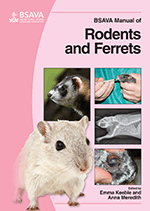
Full text loading...

The two most common endocrine diseases in ferrets (insulinoma and hyperadrenocorticism) are also the most common neoplastic diseases. Endocrine and neoplastic diseases are therefore highly linked. The combination of an insulinoma and an adrenal tumour is frequently seen. It is even possible that these ferrets have additional concurrent lymphoma. The combination of other tumours is also possible. The chapter explains clinical signs, diagnosis and treatment in the endocrine diseases hyperadrenocorticism and insulinoma. The chapter also explains diagnosis, cytology and histology for neoplastic conditions such as lymphoma, splenomegaly, integumentary tumours and chordoma.
Ferrets: endocrine and neoplastic diseases, Page 1 of 1
< Previous page | Next page > /docserver/preview/fulltext/10.22233/9781905319565/9781905319565.30-1.gif

Full text loading...






